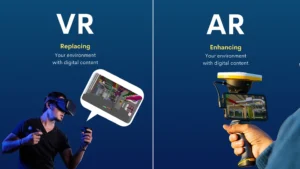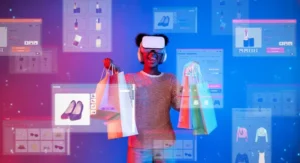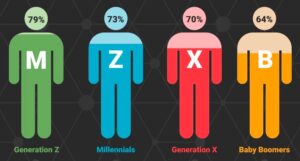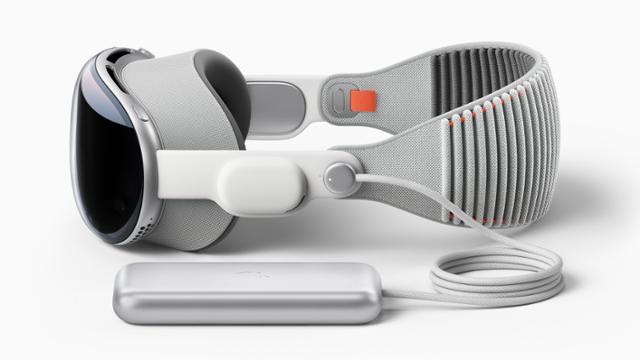Imagine being able to try on a pair of shoes or see how a sofa looks in your living room—without ever leaving your house. Augmented Reality (AR) and Virtual Reality (VR) are making this possible. With e-commerce sales projected to hit $8.1 trillion by 2026, brands using AR and VR are pulling ahead by offering customers something extraordinary: an interactive, immersive shopping experience. “The future of retail lies in delivering experiences, not just transactions,” says retail expert Doug Stephens. And AR and VR are leading that charge. These technologies blur the lines between the physical and digital worlds, giving customers a level of engagement that goes beyond traditional online shopping. Whether it’s trying out makeup virtually or exploring a digital showroom, AR and VR are revolutionizing how we shop. Let’s dive into how these tools work, why they matter, and how you can harness them for your business.
What are AR and VR?
Augmented Reality (AR) adds digital elements to the real world. Using a smartphone or tablet, customers can visualize products like furniture or clothing in their actual surroundings. For example, AR apps can let you see how a new dining table would fit in your home.

Virtual Reality (VR) creates a completely immersive digital environment. Through VR headsets, users can “walk” through a virtual showroom, inspect products in 3D, or even try on outfits in a simulated space. Unlike AR, VR replaces the real world entirely with a digital one.
Both technologies are gaining traction as consumers’ demand more personalized and engaging online shopping experiences.
How AR and VR enhance online shopping
Augmented Reality (AR) in e-commerce
AR bridges the gap between online and in-store shopping by giving customers confidence in their choices. Here’s how:
- Virtual Try-Ons: Fashion retailers use AR to let customers see how clothes, accessories, or makeup look on them before buying.
- Home Decor: Brands like IKEA offer AR apps so customers can visualize furniture in their homes, reducing doubts and increasing purchase likelihood.
Virtual Reality (VR) in e-commerce
VR offers unparalleled immersion, letting customers explore products as if they’re physically present:
- Virtual Showrooms: Create interactive, 3D shopping spaces where customers can browse shelves and get up close with products.
- 360-Degree Product Views: Allow shoppers to inspect items from every angle, providing a level of detail that photos can’t match.
Some of the ways VR/AR can influence shopping experience:

- Enhanced visualization: AR and VR let customers see how products look in real life or in virtual spaces, aiding better purchasing decisions and reducing uncertainty.
- Personalized journeys: VR offers tailored shopping experiences with product recommendations and customized assistance.
- Interactive engagement: Customers can explore and interact with products in 3D, making shopping more enjoyable.
- Reduced returns: Visualizing and interacting with products before purchase leads to greater confidence, fewer returns, and improved satisfaction.
- Gamification: AR and VR can include games and challenges that boost user engagement and brand loyalty.
Statistics on AR and VR in shopping
- Market Growth: The global AR market is projected to reach $72.7 billion by 2024, and the VR market is expected to hit $44.7 billion by the same year, indicating rapid adoption in e-commerce.
- Consumer Engagement: 61% of consumers prefer shopping with AR and VR experiences, which help enhance product visualization and confidence in purchasing.
- Purchasing Confidence: Brands integrating AR and VR have seen up to a 200% increase in conversion rates and reduced return rates.
- Generational Trends: Millennials and Gen Z are leading the way in using AR and VR, showing a strong preference for immersive shopping experiences.

- Sales Impact: Retailers using AR/VR report an average 20-30% boost in online sales compared to those who do not utilize these technologies.
Benefits for Businesses and Consumers
For businesses:
- Increased Engagement: Interactive experiences keep customers on your site longer, increasing conversion opportunities.
- Reduced Returns: Visualizing products before buying leads to fewer disappointments and fewer returns.
- Competitive Edge: Offering AR and VR differentiates your brand and builds stronger customer loyalty.
For consumers:
- Try-Before-You-Buy Confidence: Whether it’s makeup or furniture, seeing it “in place” removes guesswork.
- Enhanced Experience: Shopping becomes fun, interactive, and rewarding—a stark contrast to scrolling through static images.
Practical examples and case studies
- IKEA Place App: Customers can see how furniture fits and looks in their space using AR, streamlining decision-making.
- Sephora Virtual Try-On: Shoppers experiment with makeup products via AR, boosting both engagement and sales.
- L’Oréal ModiFace: L’Oréal’s AR tool lets users test makeup virtually. Result? A threefold increase in purchase likelihood and significantly fewer returns.
Implementing AR/VR in e-commerce strategies
Tools and Platforms for AR/VR Integration
- ARKit (Apple) & ARCore (Google): Develop AR apps for smartphones.
- Unity & Unreal Engine: Build VR experiences, including 3D models and virtual stores.
- Vuforia: Integrate AR features into existing apps easily.
Balancing costs with returns
While AR and VR require an upfront investment, the ROI can be significant. Start small:
- For AR: Launch a simple feature, like a virtual try-on tool.
- For VR: Develop a basic virtual showroom before expanding to more complex environments.
Future trends and innovations
- AI-Driven AR: Imagine personalized shopping journeys that adapt to your preferences in real time.
- Custom VR Stores: Customers could enter tailored virtual spaces, complete with personalized product recommendations.
- 5G Integration: Faster connections will make AR and VR seamless, even on mobile devices, enhancing the user experience further.
Conclusion
AR and VR aren’t just flashy add-ons; they’re game-changers for e-commerce. These technologies empower consumers to make confident, informed purchases while helping businesses reduce returns and stand out in a crowded market. The initial investment may seem steep, but the payoff—in customer satisfaction, brand loyalty, and sales—is undeniable.
So, are you ready to take the plunge into the future of shopping? Start with small, actionable steps today, and watch your brand transform.
